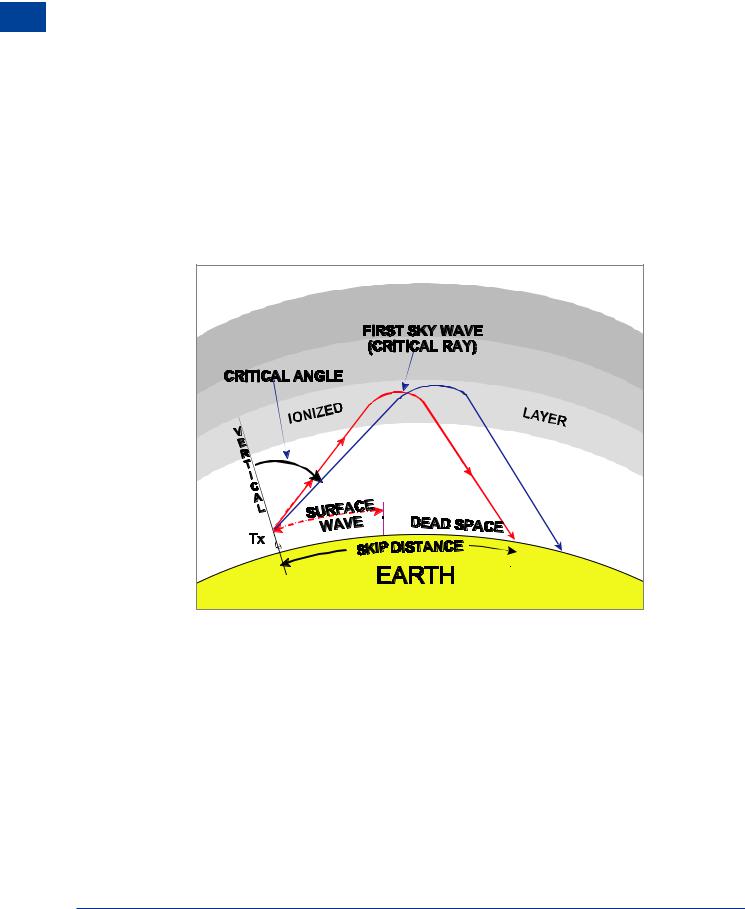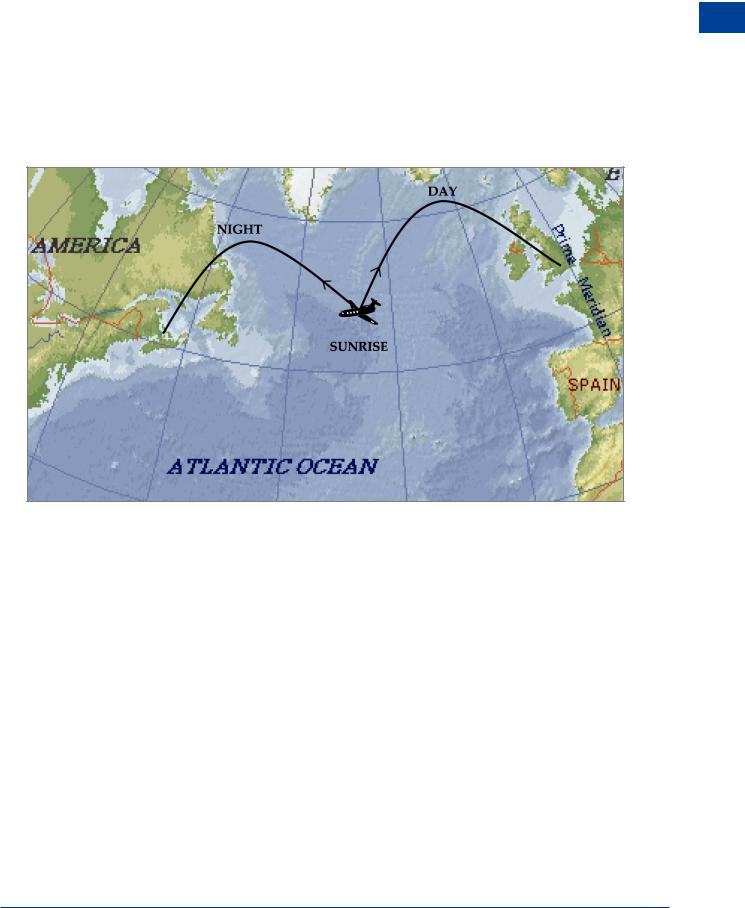
- •Textbook Series
- •Contents
- •1 Properties of Radio Waves
- •Introduction
- •The Radio Navigation Syllabus
- •Electromagnetic (EM) Radiation
- •Polarization
- •Radio Waves
- •Wavelength
- •Frequency Bands
- •Phase Comparison
- •Practice Frequency (
- •Answers to Practice Frequency (
- •Questions
- •Answers
- •2 Radio Propagation Theory
- •Introduction
- •Factors Affecting Propagation
- •Propagation Paths
- •Non-ionospheric Propagation
- •Ionospheric Propagation
- •Sky Wave
- •HF Communications
- •Propagation Summary
- •Super-refraction
- •Sub-refraction
- •Questions
- •Answers
- •3 Modulation
- •Introduction
- •Keyed Modulation
- •Amplitude Modulation (AM)
- •Single Sideband (SSB)
- •Frequency Modulation (FM)
- •Phase Modulation
- •Pulse Modulation
- •Emission Designators
- •Questions
- •Answers
- •4 Antennae
- •Introduction
- •Basic Principles
- •Aerial Feeders
- •Polar Diagrams
- •Directivity
- •Radar Aerials
- •Modern Radar Antennae
- •Questions
- •Answers
- •5 Doppler Radar Systems
- •Introduction
- •The Doppler Principle
- •Airborne Doppler
- •Janus Array System
- •Doppler Operation
- •Doppler Navigation Systems
- •Questions
- •Answers
- •6 VHF Direction Finder (VDF)
- •Introduction
- •Procedures
- •Principle of Operation
- •Range of VDF
- •Factors Affecting Accuracy
- •Determination of Position
- •VDF Summary
- •Questions
- •Answers
- •7 Automatic Direction Finder (ADF)
- •Introduction
- •Non-directional Beacon (NDB)
- •Principle of Operation
- •Frequencies and Types of NDB
- •Aircraft Equipment
- •Emission Characteristics and Beat Frequency Oscillator (BFO)
- •Presentation of Information
- •Uses of the Non-directional Beacon
- •Plotting ADF Bearings
- •Track Maintenance Using the RBI
- •Homing
- •Tracking Inbound
- •Tracking Outbound
- •Drift Assessment and Regaining Inbound Track
- •Drift Assessment and Outbound Track Maintenance
- •Holding
- •Runway Instrument Approach Procedures
- •Factors Affecting ADF Accuracy
- •Factors Affecting ADF Range
- •Accuracy
- •ADF Summary
- •Questions
- •Answers
- •8 VHF Omni-directional Range (VOR)
- •Introduction
- •The Principle of Operation
- •Terminology
- •Transmission Details
- •Identification
- •Monitoring
- •Types of VOR
- •The Factors Affecting Operational Range of VOR
- •Factors Affecting VOR Beacon Accuracy
- •The Cone of Ambiguity
- •Doppler VOR (DVOR)
- •VOR Airborne Equipment
- •VOR Deviation Indicator
- •Radio Magnetic Indicator (RMI)
- •Questions
- •In-flight Procedures
- •VOR Summary
- •Questions
- •Annex A
- •Annex B
- •Annex C
- •Answers
- •Answers to Page 128
- •9 Instrument Landing System (ILS)
- •Introduction
- •ILS Components
- •ILS Frequencies
- •DME Paired with ILS Channels
- •ILS Identification
- •Marker Beacons
- •Ground Monitoring of ILS Transmissions
- •ILS Coverage
- •ILS Principle of Operation
- •ILS Presentation and Interpretation
- •ILS Categories (ICAO)
- •Errors and Accuracy
- •Factors Affecting Range and Accuracy
- •ILS Approach Chart
- •ILS Calculations
- •ILS Summary
- •Questions
- •Answers
- •10 Microwave Landing System (MLS)
- •Introduction
- •ILS Disadvantages
- •The MLS System
- •Principle of Operation
- •Airborne Equipment
- •Question
- •Answer
- •11 Radar Principles
- •Introduction
- •Types of Pulsed Radars
- •Radar Applications
- •Radar Frequencies
- •Pulse Technique
- •Theoretical Maximum Range
- •Primary Radars
- •The Range of Primary Radar
- •Radar Measurements
- •Radar Resolution
- •Moving Target Indication (MTI)
- •Radar Antennae
- •Questions
- •Answers
- •12 Ground Radar
- •Introduction
- •Area Surveillance Radars (ASR)
- •Terminal Surveillance Area Radars
- •Aerodrome Surveillance Approach Radars
- •Airport Surface Movement Radar (ASMR)
- •Questions
- •Answers
- •13 Airborne Weather Radar
- •Introduction
- •Component Parts
- •AWR Functions
- •Principle of Operation
- •Weather Depiction
- •Control Unit
- •Function Switch
- •Mapping Operation
- •Pre-flight Checks
- •Weather Operation
- •Colour AWR Controls
- •AWR Summary
- •Questions
- •Answers
- •14 Secondary Surveillance Radar (SSR)
- •Introduction
- •Advantages of SSR
- •SSR Display
- •SSR Frequencies and Transmissions
- •Modes
- •Mode C
- •SSR Operating Procedure
- •Special Codes
- •Disadvantages of SSR
- •Mode S
- •Pulses
- •Benefits of Mode S
- •Communication Protocols
- •Levels of Mode S Transponders
- •Downlink Aircraft Parameters (DAPS)
- •Future Expansion of Mode S Surveillance Services
- •SSR Summary
- •Questions
- •Answers
- •15 Distance Measuring Equipment (DME)
- •Introduction
- •Frequencies
- •Uses of DME
- •Principle of Operation
- •Twin Pulses
- •Range Search
- •Beacon Saturation
- •Station Identification
- •VOR/DME Frequency Pairing
- •DME Range Measurement for ILS
- •Range and Coverage
- •Accuracy
- •DME Summary
- •Questions
- •Answers
- •16 Area Navigation Systems (RNAV)
- •Introduction
- •Benefits of RNAV
- •Types and Levels of RNAV
- •A Simple 2D RNAV System
- •Operation of a Simple 2D RNAV System
- •Principle of Operation of a Simple 2D RNAV System
- •Limitations and Accuracy of Simple RNAV Systems
- •Level 4 RNAV Systems
- •Requirements for a 4D RNAV System
- •Control and Display Unit (CDU)
- •Climb
- •Cruise
- •Descent
- •Kalman Filtering
- •Questions
- •Appendix A
- •Answers
- •17 Electronic Flight Information System (EFIS)
- •Introduction
- •EHSI Controller
- •Full Rose VOR Mode
- •Expanded ILS Mode
- •Full Rose ILS Mode
- •Map Mode
- •Plan Mode
- •EHSI Colour Coding
- •EHSI Symbology
- •Questions
- •Appendix A
- •Answers
- •18 Global Navigation Satellite System (GNSS)
- •Introduction
- •Satellite Orbits
- •Position Reference System
- •The GPS Segments
- •The Space Segment
- •The Control Segment
- •The User Segment
- •Principle Of Operation
- •GPS Errors
- •System Accuracy
- •Integrity Monitoring
- •Differential GPS (DGPS)
- •Combined GPS and GLONASS Systems
- •Questions
- •Answers
- •19 Revision Questions
- •Questions
- •Answers
- •Specimen Examination Paper
- •Appendix A
- •Answers to Specimen Examination Paper
- •Explanation of Selected Questions
- •20 Index

2 |
|
Radio PropagationTheory |
|
||
|
|
|
Theory Propagation Radio 2
HF Communications
Over inhabited land areas VHF communications are ideal for all communications between aircraft and ground. However, over oceans and uninhabited land areas, long range systems are required. Satellite Communications (SatCom) are not yet the norm, so long range communication must be provided by surface wave or sky wave propagation.
To achieve ranges of 2000 - 3000 NM using surface wave propagation would require low frequencies either from the lower end of LF band or the upper end of VLF band. Communication systems utilizing these frequencies would require relatively complex equipment with an associated weight penalty. Lower frequencies are also subject to greater static interference than higher frequencies, making such systems somewhat tedious to use. Furthermore, data rates associated with low frequencies are notoriously low.
Currently, therefore, the only practical solution is HF Communications utilizing sky wave propagation. In the future, no doubt, SatCom will become commonplace.
Figure 2.14
The maximum usable frequency (MUF) for a given range will be that of the first returning sky wave and this is the ideal frequency for that range because it will have had the shortest path through the ionosphere, and therefore, will have experienced less attenuation and contain less static interference. However, since the ionization intensity fluctuates, a decrease in ionization would result in an increase in skip distance and hence loss of signal. So a compromise frequency is used, known as the optimum working frequency (OWF), which by decades of experimentation and experience has been determined to be 0.85 times the MUF.
Since ionization levels are lower by night than by day it follows that the frequency required for use at a particular range by night will of necessity be less than the frequency required for use by day. A good rule of thumb is that the frequency required at night is roughly half that required by day.
32

Radio PropagationTheory |
|
2 |
|
||
|
|
|
Because skip distance increases as frequency increases, the range at which communication is required will also influence the selection of the frequency to be used. Short ranges will require lower frequencies and longer ranges will require higher frequency.
A typical example of the sort of problem that may appear is:
An aircraft on a flight from London, UK to New York, USA is in mid-Atlantic at sunrise.
The pilot is in communication with the UK on a frequency of 12 MHz.
What frequency can the pilot expect to use with the USA? (See Figure 2.16).
Figure 2.15 HF Communications Mid-Atlantic
Answer: 6 MHz.
The wave will be refracted halfway between the aircraft and the UK, and halfway between the aircraft and the USA. Midway between the aircraft and the UK it is day, so a relatively high frequency will be required. Midway between the aircraft and the USA it is night so a relatively low frequency will be required.
Radio Propagation Theory 2
33

2 |
|
Radio PropagationTheory |
|
||
|
|
|
Theory Propagation Radio 2
Propagation Summary
The propagation characteristics of each of the frequency bands are summarized below, where propagation paths are in brackets this indicates that the path is present but not normally utilised.
Frequency Band |
Propagation Path |
|
|
|
|
LF |
Surface Wave |
|
(Sky Wave) |
||
|
||
|
|
|
MF |
Surface Wave |
|
(Sky Wave) |
||
|
||
|
|
|
HF |
Sky Wave |
|
(Surface Wave) |
||
|
||
|
|
|
VHF |
Space Wave |
|
|
|
|
UHF |
Space Wave |
|
|
|
|
SHF |
Space Wave |
|
|
|
|
EHF |
Space Wave |
|
|
|
Figure 2.16
34

Radio PropagationTheory |
|
2 |
|
||
|
|
|
Super-refraction
This is a phenomenon which is significant at frequencies above 30 MHz (that is VHF and above). Radio waves experience greater refraction, that is, they are bent downwards towards the earth’s surface more than in normal conditions, giving notable increases in line of sight range to as much as 40% above the usual.
The conditions which give rise to super-refraction are:
•Decrease in relative humidity with height
•Temperature falling more slowly with height than standard
•Fine weather and high pressure systems
•Warm air flowing over a cooler surface
In extreme cases when there is a low level temperature inversion with a marked decrease in humidity with increasing height (simply, warm dry air above cool moist air), a low level duct may be formed which traps radio waves at frequencies above 30 MHz giving extremely long ranges. This phenomenon is known as duct propagation and can lead to exceptionally long ranges. When interference is experienced on UK television channels from continental stations, the reason for this is the forming of such a duct.
This phenomenon is most common where warm desert areas are bordering oceanic areas, e.g. the Mediterranean and Caribbean seas. It can also occur in temperate latitudes when high pressure predominates, particularly in the winter months when the dry descending air in the high pressure system is heated by the adiabatic process and is warmer than the underlying cool and moist air.
Sub-refraction
Much rarer than super-refraction, but still of significance in radio propagation, sub-refraction causes a reduction in the normal refraction giving a decrease in line of sight range by up to 20%.
The conditions which give rise to sub-refraction are:
•An increase in relative humidity with increasing height
•Temperature decreasing with increasing height at a greater rate than standard
•Poor weather with low pressure systems
•Cold air flowing over a warm surface
Radio Propagation Theory 2
35

2 |
|
Radio PropagationTheory |
|
||
|
|
|
Theory Propagation Radio 2
36
